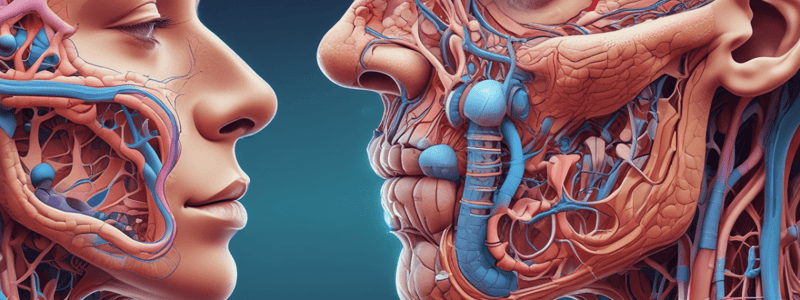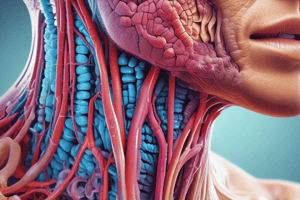Podcast
Questions and Answers
What is the main cause for an increase in breathing rate?
What is the main cause for an increase in breathing rate?
- High O2 concentration in the blood
- Low CO2 concentration in the blood
- High H+ concentration in the blood (correct)
- High pH in the blood
Why does strenuous exercise lead to an increase in breathing rate?
Why does strenuous exercise lead to an increase in breathing rate?
- To increase CO2 levels in the blood
- To rid the body of excess O2
- To increase pH levels in the blood
- To get rid of H+ that accompany lactate (correct)
What stimulus is needed to stimulate chemoreceptors and increase breathing?
What stimulus is needed to stimulate chemoreceptors and increase breathing?
- High pH levels
- Decreased H+ concentration
- High CO2 levels
- Low O2 levels (correct)
Which gas has greater solubility in the blood?
Which gas has greater solubility in the blood?
What is hypernea?
What is hypernea?
What is the typical starting altitude at which altitude sickness may occur?
What is the typical starting altitude at which altitude sickness may occur?
What is the function of the cilia in the nose?
What is the function of the cilia in the nose?
Which structure closes off the tube in the larynx when swallowing?
Which structure closes off the tube in the larynx when swallowing?
Where does gas exchange primarily occur in the respiratory system?
Where does gas exchange primarily occur in the respiratory system?
What is the primary function of the lungs?
What is the primary function of the lungs?
Which factor plays a crucial role in pulmonary ventilation?
Which factor plays a crucial role in pulmonary ventilation?
What does the transpulmonary pressure represent?
What does the transpulmonary pressure represent?
Which muscle plays a key role in the pressure change during inspiration and exhalation?
Which muscle plays a key role in the pressure change during inspiration and exhalation?
What defines the respiratory cycle?
What defines the respiratory cycle?
What is the functional residual capacity after a normal tidal expression?
What is the functional residual capacity after a normal tidal expression?
What does anatomical dead space refer to in the respiratory system?
What does anatomical dead space refer to in the respiratory system?
Flashcards are hidden until you start studying
Study Notes
Factors Influencing Breathing Rate
- Increased carbon dioxide levels are the main cause for an increase in breathing rate.
- Strenuous exercise raises breathing rate due to increased metabolic demands and the need for more oxygen and carbon dioxide removal.
Chemoreceptors and Stimuli
- Chemoreceptors are stimulated by changes in blood pH, carbon dioxide, and oxygen levels, prompting adjustments in breathing rate.
Gas Solubility
- Carbon dioxide has greater solubility in blood compared to oxygen, allowing for easier transport and exchange during respiration.
Definitions and Concepts
- Hypernea refers to an increase in the depth and rate of breathing, often in response to metabolic needs.
- Altitude sickness may begin at altitudes above 2,400 meters (8,000 feet) due to lower oxygen availability.
Respiratory Structures and Functions
- Cilia in the nose help to filter and trap particles, protecting the respiratory tract from irritants and pathogens.
- The epiglottis closes off the larynx during swallowing, preventing food and liquid from entering the airway.
Gas Exchange and Lung Functions
- Gas exchange occurs primarily in the alveoli, small air sacs in the lungs where oxygen and carbon dioxide are exchanged.
- The primary function of the lungs is to facilitate this gas exchange and maintain oxygenation of the blood.
Pulmonary Ventilation
- The diaphragm plays a crucial role in the pressure changes necessary for pulmonary ventilation during both inspiration and expiration, contracting to allow air intake.
Respiratory Cycle
- The respiratory cycle encompasses one complete inhalation and exhalation, facilitating gas exchange and maintaining respiratory function.
Lung Capacities and Spaces
- Functional residual capacity is the volume of air remaining in the lungs after a normal tidal expiration, indicating lung health and reserve.
- Anatomical dead space refers to air in the respiratory system that does not participate in gas exchange, including parts like the trachea and bronchi.
Studying That Suits You
Use AI to generate personalized quizzes and flashcards to suit your learning preferences.




